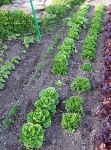
See Manx Hoes and other tools in our online shop
Video of Manx Hoe in use
The Lazy Dog Tool Company are making a series of tools that offer a new way of keeping plants free of weeds. Unlike most hoes, the Manx tools do not use a cutting edge or sharp corner in their looped design but work by pulling young weeds out of the earth ‘roots and all’ — this is achieved by a stainless-steel bar being pulled or pushed through the top inch of soil.
Who thought out the Manx Range of Hoes?
They were originally devised by Alex Maddrell, who is a remarkable grower, farmer and life-boatman from the Isle of Man. Alex looks after an extensive vegetable plot and his early versions of these hoes were made of fencing wire and old golf clubs. Lazy Dog Tools have now developed those tools and have applied Alex’s growing ideas to their own vegetable plots. We know the tools are a quick, safe and effective aid to growing. Alex keeps his vegetables free of weeds by only using these hoes.

Why are these Manx Hoes special?
They are rounded and elongated which allows operation right up to the stems of plants, without causing accidental damage – this makes Manx hoes quicker and safer to use than traditional, sharp-edged tools. They are brilliant among leafy vegetables (courgette or squash), or closely planted leeks, onions... ...and in greenhouses.
Who will use these Manx tools?
Both the commercial smallholder and the allotment gardener will make useful friends of the Manx Hoes. We know that in the hands of less skilled gardeners (or the disabled), they are far less likely to be the cause of accidental damage to plants, whether flowers or vegetables. They are ideal for people who require ease of use.
Where, When?
The Hoes work best in recently sown beds, where the soil is friable and the weeds still young – in these conditions, gardeners are able to quickly hook out seedling weeds in clusters and ‘tap’ them into a bucket for disposal (or decide to leave them in the sun to dry). The Hoes have been thought out ingeniously – for example, the horizontal hoeing bars are shaped so that they work less deeply near the roots of plants. The narrow end of the "Original Hoe" can be used to hook out individual weeds. For weeds whose stems are actually touching crop-plants, we have produced the special Mini Hoe.

'Weed Early'
Alex’s advice is to 'Use the hoes lightly and often'. Seedling weeds are much simpler to remove than older ones and Alex recently told us that he had cleared each side of a 25ft row of lettuce in less than a minute — in other words, if your rows are straight and well organized, it is possible to work at near walking speeds with these hoes.
Alex's System
Carefully prepare the well-fed* seedbed in advance of sowing, using a rake (or rotavator) A stale seed-bed will allow weed seeds the chance to germinate in advance of sowing. Clear those seedling weeds and mark out your rows with pegs and strings allowing for the mature size of the plants. Plan a central access path between every four rows. The spaces between rows should be greater by at least 4" (10 cms). than the width of the hoe head. Use the narrow end of the hoe to make the seed drill by pulling it along the edge of the string. Now plant the seeds and cover them by gently pulling the soil over the seeds with horizontal hoe bar. As crops start to appear and develop, run the hoe regularly between the marked rows: This is done with either a pushing or pulling action. Adopt a 'Look' and 'Do' approach and once the crop-plants emerge, use of the hoe will allow the plants to flourish.
*Compost & Seaweed in Alex’s garden















